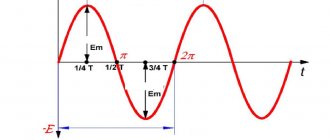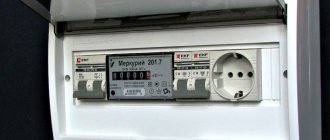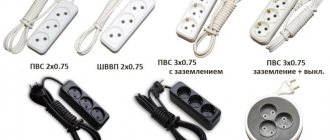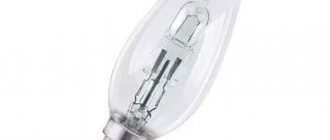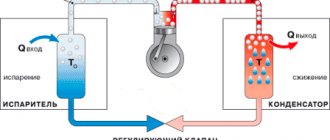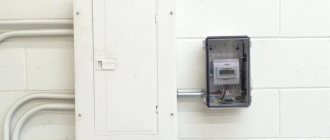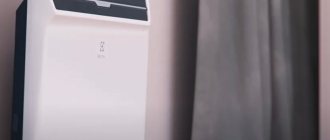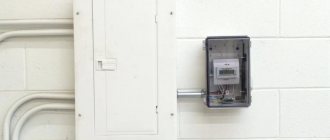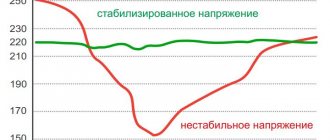In Soviet times, electrical energy consumption in apartments and private houses was relatively small. However, the situation has changed in recent decades. A modern home contains a large number of household appliances, which together consume a lot of energy.
As a result, there was a need for three-phase power supply, which made it possible to organize more powerful channels for supplying electricity. In addition, many types of equipment, such as electric boilers, are produced only in three-phase versions. To organize a connection of this type, you need a three-phase socket, which will be discussed in this article.
Connection diagram
Three-phase power supply is connected through three phases (L1, L2, L3), as well as neutral (N). In this case, most of the consumption will be distributed evenly over one phase. A dedicated group is created for a three-phase load. The figure below shows a three-phase circuit in a building powered by a 380 V network.
Three-phase circuit in a building powered by a 380 V network
A three-pole 40-amp circuit breaker is installed in the input part. Three wires are routed to the machine (black, red and brown). In the upper right part of the figure there is a three-phase meter. The blue wire (zero) is connected to the electric meter. Next, the zero is sent from the output of the device to the zero bus, after which it is distributed among the groups.
At the bottom of the picture you can see two groups of sockets and one group of lighting. Each group has its own phase. The three-phase circuit is separated into a separate line. The simplest scheme involves connecting the circuit through a machine and outputting it to sockets. Three-phase loads are transferred through sockets using plugs.
The power level of a three-phase circuit breaker and socket may differ depending on the power of household appliances that will load the network. There are different types of three-phase sockets. On average, each kilowatt will require 2.5 amperes. If the connection is made using an RCD, a more accurate calculation will be required.
Connection details
As already mentioned, the outlet can be designed for hidden or open installation. In the latter case, the device is mounted on the wall, and in the case of a hidden installation, the main part of the socket is located in the wall.
The body of the device performs not only an aesthetic, but also a protective function. Thanks to the external panel, access of foreign substances to live elements is protected. The panel also protects residents from accidental contact with live parts.
Electrical power is directed to the cable connectors and received from the plug by consumers. The wiring is connected to the contacts through clamps on screw terminals.
Flexible electrical cables can be used with power connectors. These cables include stranded wires and are ideal for temporary use or for feeding cables placed on a vibrating mobile base.
Note! To ensure the quality of contact in the terminals of a socket with multi-core wiring, it requires regular maintenance. It is recommended to use tips rather than tinning.
The most important technical aspect regarding electrical connectors is the current rating that can pass through the device without heating the contacts. Heating depends on the magnitude of the current, and the magnitude of the latter is directly dependent on the cross-sectional area of the current-carrying element, as well as the area of contact connection.
Socket device
Three-phase devices may vary in design, but they always have at least four contacts. Three contacts are phase, and the fourth is ground. The figure below shows a three-phase connector with a plug. These devices together form detachable contacts.
The selection of the required number of connectors is carried out in accordance with the following recommendations:
- To connect using a “triangular” diagram, you will need four connectors (three phases - A, B, C - and a protective zero PE).
- If the circuit is designed in the form of a “star”, five sockets are needed (three phases - A, B, C, zero - N and protective zero PE).
- If you need very high quality protection from electrical damage, seven connectors are used (three phases with three zeros and PE). In this case, each phase is equipped with a separate RCD.
The four-pin connector is used only in delta load connection circuits. Five contacts can be used in both delta and star configurations. Power is connected only to certain terminals. After this, you can connect all kinds of electrical devices through the outlet.
The wires connected to the three-phase connector must have a diameter of at least 2.5 square millimeters. In the case of high loads, the need for diameter can increase to 6 square millimeters.
The classification of sockets is carried out according to the following criteria:
- Installation method. Open type modifications are mounted for external wiring and fixed on the wall (overlay fittings). Such models are used both in the interior of the house and in the façade. Overhead fittings are also used in high humidity environments. If the wiring is hidden, closed connectors are most often used, which are recessed into the wall during installation. Installing such sockets is more labor-intensive, since you will need to create a recess in the wall and install a socket box.
- Resistance to environmental factors (degree of protection) is determined by two letters - IP and two numbers. The first digit indicates the level of protection against foreign particles: 0 - no protection, 6 - the greatest protection. The second digit indicates the level of moisture protection: 0 - the device is not protected, 8 - the device can be used even under water. The most common protection class is IP44, which allows you to protect the device from both dust and moisture.
- Purpose. Sockets are produced without the use of grounding, which are connected to electrical appliances without a grounding contact. If the device is equipped with a contact, the connection is made using special connectors (CEE 7/5) using elastic side contacts (CEE 7/4). There are connectors on the market with protective curtains made of plastic. The curtains open only if the plug pins are directed evenly into the sockets. Some modifications may be equipped with plug ejectors, timers or RCDs.
What type of plug is used in Russia?
To choose the right type of plug in Russia on Aliexpress, you need to understand the standards of electrical outlets. Otherwise, you risk buying equipment with a plug that is not suitable for our electrical network.
Until now, there is no single standard in the world for the types of electrical sockets and plugs, which is due to different voltages and current frequencies in the power grids of different countries. But even in countries where a voltage of 220 Volt/50 Hz is used (as in Russia), the design of electrical outlets varies greatly.
Plug options in different countries:
- UK – British plug with three flat pins. It is used in the UK and several other countries.
- AU - plug is used in China itself, as well as in Australia and some other countries.
- EU is the plug we are familiar with, called the European plug. This is exactly what is suitable for Russia, Belarus and other post-Soviet countries, EU countries, Turkey and many other countries.
- US – American plug, suitable for the USA, Japan, countries of the South American continent.
Coupons for discounts on AliExpress
Coupons allow you to save up to 50%
from the order cost.
Hurry up to get your discount on Aliexpress
, as the offer is limited!
Get coupon Remaining: 11 coupons
So, of the four plug type options, only “EU” is suitable for Russia. This is what you need to select when placing your order.
Types of connectors
Power sockets and plugs for 380 V are selected based on safety standards. Below we consider the characteristics of such devices, their advantages and disadvantages.
Power connectors RSH-VSh
This plug-type model refers to three-phase power connectors. Used to connect both household and industrial equipment. Plug connections are designed for networks with voltages up to 380 V and rated current from 25 to 30 A. Screw cable clamps are used, thanks to which the contacts become especially reliable. RSh-VSh have carbolite bodies.
The contact part can be flat and in the form of a cylinder. Combination contacts are also available. Spring clamps are used, which increases the quality of electrical connections. To protect against children, special plugs are used to cover the sockets.
Note! It is recommended to purchase plug connectors in pairs. In this case, the elements of the pairs must fit each other.
The cost of the RSh-VSh is approximately 100 rubles, which is cheaper than similar competing models. The disadvantage of RSH-VSh is their color - it is black. This color does not always coincide with the design of the room. Most often, RSh-VSh is used in technical or utility rooms, but the connector can also be used in the kitchen (for example, to supply voltage to an electric stove).
Power connectors SSI-125
The markings indicate the following information: Fixed type IEK power connector for 32 Amp current rating. The connector is designed for five poles, three phases, ground and neutral.
The modification is operated at voltages up to 380 V and belongs to protection class IP44. The degree of protection indicates the possibility of using SSI-125 in conditions of high humidity.
The connector is fixed to the wall using dowels. You can connect any equipment to three phases, including electric motors, machine tools, pumping and boiler equipment, heat guns and electric furnaces. The power of the equipment can be between 63 and 125 A.
The terminals are protected by seals. Each core is fixed using clamping screws. This is not a very reliable option, since when pressed, the screw slightly deforms the core. Therefore, it is recommended to use another type of screw connection - with a wire loop and a pressure plate.
Note! If multi-wire conductors are connected, you cannot do without a tip.
380V sockets
Before we talk about ways to connect 380V sockets, let's look at their modifications and features. As an example, we will have an IEK 380 V socket, the model range of which allows us to consider all possible connection options
Types of 380V electrical outlets
First, let's look at the types of 380V sockets. Indeed, depending on the modification, their connection method also changes. Therefore, let's determine what types of sockets exist.
A variety of 380V socket models
- Before proceeding directly to the consideration of sockets, let's remember the school physics course. As you all should remember, our country uses a three-phase 380V network. Three-phase - this means that we have three phase wires.
Differences between phase and line voltages
- The voltage between each of these wires and ground is 220V. This is called phase voltage. In most cases, this is what is supplied to our houses and apartments. For this, one of the three phase wires and a neutral wire are used (see Grounding and neutral wire: how to distinguish).
Phase and line voltage
- But the voltage between the phase wires is 380V. And this voltage is called linear. In this case, a voltage of 380V is obtained when measured between any two phase wires. That is, we can get a 380V network using not all three, but only two phase wires.
- This two-phase connection is often used in various electrical installations. At home, you can find this type of connection in electric stoves, as well as in some other electrical installations.
- According to the PUE standards, a three-phase electrical network up to 1000V can be four or five wires. That is, to the three phase conductors we will add one or two more. What kind of conductors are these?
Number of wires for three-phase and single-phase networks
- First of all, this is a neutral conductor, which is necessary if the electrical installation has circuits operating at a voltage of 220V. Usually this is starting equipment or protection circuits. Although it is quite possible that in your electrical installation this is the operating voltage. The neutral conductor according to clause 1.1.29 of the PUE is designated by the symbol “N”.
- In addition, for almost any 380V network, the instructions provide for a protective grounding conductor. It is necessary to protect a person from touch stress. That is, if the insulation in your device leaks and it shorts to the housing, the grounding conductor will create a safe potential on the housing. Such a conductor is designated as “PE”.
| Socket 380V 2P+PE | Based on the above, there are several types of 380V outlets. The first type is a 2P+PE socket. It has two phase or as they are also called power contacts, as well as one grounding contact. |
| Socket 380 3P+PE | The next possible option is a 3P+PE socket. It has three power contacts and one grounding contact. |
| Another option offered on the market is the 3P+N socket and plug. It is no different from a 3P+PE socket and is actually this socket. This is where the sellers make a mistake, positioning it incorrectly. |
| The last possible option is a 380 V electrical socket 3P+PE+N. This type of socket has three contacts for connecting three phase conductors, one contact for connecting a grounding conductor and one contact for connecting a neutral wire. |
Features of 380V sockets
Considering the types of sockets, it should be noted that they differ from the usual 220V sockets not only visually. There are a lot of differences here that are also worth paying attention to.
Types of 380V sockets
So:
- First of all, this is blocking the plug and socket from an asymmetrical connection. The fact is that for 380V sockets it is very important that the phase contact of the plug is connected to the phase contact of the socket. The same applies to neutral and grounding conductors. Otherwise, a short circuit may occur.
- In order to eliminate the possibility of such an asymmetrical connection, manufacturers place the contacts at a special angle, of different sizes and with a special guide. This virtually eliminates the possibility of incorrect activation.
The photo shows the norms for the location of contacts and locking devices
- Another feature of such sockets is the presence of a lock from turning on under load. The fact is that the loads of 25, 63, 125A for which these sockets are designed are quite significant. And the socket does not have arc-extinguishing elements to turn off such currents. As a result of trying to remove a plug and socket under load, you can not only burn them completely, but also get very dangerous electrical and thermal burns.
380V socket with electrical interlock
Therefore, manufacturers equip sockets with mechanical or electrical interlocking. Since electrical interlocking is quite complicated in design and connection, and the price of such an outlet will be an order of magnitude higher, mechanical interlocking is preferably used.
Mechanical locking also comes in several types. But the market often offers sockets with simple manual locking.
It blocks the plug and socket from accidental loss of contact, and also requires a certain action from the person before removing the plug. This action is supposed to make the person remember to turn off electrical equipment before unplugging it.
Connection instructions for 380 V
Connecting a three-phase outlet is more complicated when compared with a 220 V network, where phase and neutral can be swapped.
The connection is made in this order:
- Turn off the voltage in the panel. We test the voltage with an indicator screwdriver.
- We connect phases A, B and C to contacts L1, L2, L3. Moreover, the sequence is arbitrary (it only affects which direction the electric motor will rotate).
- We connect zero to contact N.
- We connect the grounding conductor to PE.
- We supply power, test the phase, measure the voltage at the terminals.
What to do if you bought the wrong type of plug on Aliexpress?
When choosing electrical goods on foreign trading platforms, you need to carefully look at whether the lot in question has the type of plug that is used in Russia. You need to be especially careful if the parameters indicate a US connector - in the USA, the network uses a voltage of 110 V, and such plugs will not fit into the Russian electrical network.
If the specifications do not indicate the type of connector, a photo will help make sure that the device has a European standard plug - you can ask the seller to make one and send it. But sometimes, especially with cheap electrical devices, there is no choice of plug type. There is no need to be afraid of this - if you are satisfied with all other parameters of the product, there is a way out.
Installation check
After installing a three-phase outlet, before starting operation, always check the circuit for errors.
For most devices, phases to a plug or socket can be connected to any terminals, except those intended for working and protective cables.
In some cases, some equipment with three-phase motors will not work correctly, because... The direction of rotation of the engine will be opposite. For normal operation, any two wiring with phases should be interchanged with each other.
At the same time, if you confuse the connections of the working and protective zero, this can lead to dire consequences: the protection against short circuit and electric shock will be disrupted, and there will be a risk of using the electrical installation.
Immediately after completion of installation work, perform the following actions: Carry out a thorough inspection of all contacts for their reliability. Measure the parameters of the insulation resistance of the cores.
The insulation resistance is checked with a multimeter or tester.
To do this you need:
- One probe is placed on the terminal with the protective wire, the other touches the remaining terminals in turn.
- The first probe is placed on the terminal with the working zero, the second is alternately passed along the contacts with the phases.
- One probe is applied to the phase point, the other is carried out along the remaining phases.
- Check the remaining phases.
If during any test there is a small resistance, this indicates an installation error or a malfunction of the wiring itself. If everything is done correctly, there will be a dash on the dial of the device, indicating a very high resistance. Only under this condition can the position of the machine petal be moved to “ON”.
Industrial sockets
Connectors used in industrial applications are subject to significantly more stringent performance requirements in terms of reliability and safety. In particular, a connector or block of industrial power outlets must meet the following characteristics:
- Protection against sudden power failure. In production conditions, accidental disconnection of a consumer can lead to equipment failure.
- Protection from moisture, dust particles, and aggressive chemicals. Special adapters are produced for use in places with a high risk of fires, explosions, etc.
- The need for special connectors for different voltage ratings and for differently configured networks. In this case, devices should be specialized, not universal.
It is allowed to use industrial sockets in everyday life. For example, electric stoves, caravans, generators, etc. can be connected through them.
Cable characteristics
In residential premises, two-core and three-core wires are mainly used for wiring installation. The former are suitable for sockets without grounding, the latter - for sockets with grounding. To organize lighting, a wire with a cross-section of 1.5 mm2 is sufficient.
It is recommended to use the characteristics of the most powerful electrical appliance: use them as a guide when choosing the brand and cross-section of the wire.
The most commonly used types of cables are:
- VVG and VVG non-flammable - a power wire that can operate in networks with voltages of 220 and 380 V. VVG stands for “vinyl-vinyl-naked” cable, that is, polyvinyl chloride plastic is used as a sheath and insulation, and multi-wire is used as a conductor copper conductor. Wire cross-section - from 1.5 to 50 mm2 for 1, 2, 3, 4 wires and from 1.5 to 25 mm2 for five- and six-core conductors.
- PVA is a cable made of twisted copper conductors in a vinyl sheath, the insulation of which is made using polyvinyl chloride resin. It has good flexibility, corrosion resistance, and impeccable performance characteristics. Suitable for organizing wiring from a distribution box in residential premises, connecting sockets for electrical appliances. The number of current-carrying cores is 2 – 5, cross-section is 0.75 – 2.5 mm2.
- NYM is a wire for installation of fixed electrical wiring, manufactured using German technology. The wire structure consists of copper cores, the space between which is filled with a non-flammable non-vulcanized rubber mixture, and the conductor sheath is made of non-flammable polyvinyl chloride plastic compound. The power cable operates in networks with voltages up to 660 V at a current frequency of 50 Hz. Cable design - 2, 3, 4, 5 cores, cross-section - from 1.5 to 70 mm2.
What cross-section should the wire be for sockets in residential premises? For household wiring, when connecting sockets, it is rational to use a two- and three-core copper conductor with a cross-section of 2.5 - 6 mm2, the current-carrying parts of which are isolated from each other and protected by an outer sheath of non-flammable polyvinyl chloride.

